Beginnings
The Holy Cross Dispute
Holy Cross is an all-girl Catholic primary school in what had been a mixed area until the beginning of The Troubles. The Ardoyne area is segregated with loyalists to the north and nationalists to the south of the wall backing Alliance Avenue, and over time a permanent wall was built immediately to the north of Alliance Avenue. Holy Cross was on the opposite side of the peace line from its catchment, although only about 200m from it, and remained relatively undisturbed but for minor incidents of vandalism for three decades.
The origins of the dispute are contested. In December 2000, Protestant taxi driver Trevor Kell was shot dead in Ardoyne. The Provisional Irish Republican Army (IRA) were suspected of involvement as forensic evidence linked the bullet with an IRA shooting in 1997. Later, the IRA was blamed for the “punishment shooting” of two men, one of whom is believed to have been questioned over Kell’s death. Tension built after the murder that led in the days before the protests to youths from both communities raising more and more flags along Ardoyne Road.[3]
Holy Cross students began complaining to parents of threatening verbal abuse when passing the Protestant area.
Loyalists began to blockade the nearby Holy Cross Primary School on 19 June 2001, when children left for the day accompanied by their parents.
The Loyalists continued the picket on Monday 18 June. By Tuesday 19 June, riot police were deployed to escort children through the picket line. On Wednesday 20 June the loyalist protesters blocked the front gates of the school and forced it to close, while officers of the Royal Ulster Constabulary (RUC) advised parents not to attempt to enter the school. The stand-off continued until the end of school term on 29 June, with loyalists blockading the Ardoyne Road, and the RUC refusing to force children through.
Talks between residents from the two parts of Ardoyne took place over the summer, but no agreement was reached.
The protest resumed on Monday 3 September, the first day of the Autumn school term. The Police Service of Northern Ireland (over the summer the RUC had undergone a name change), supported by the British Army were by then better prepared and managed to force a path through the protesters. On 4 September the protest escalated when a PSNI officer sustained a foot injury from a blast bomb, with more blast bombs being thrown at police on 5 September.
The world media had descended on Ardoyne from the start of September until the attacks on the World Trade Center in New York on 11 September caused attention to be drawn to New York and then Afghanistan.
On Thursday 6 September, the loyalist picket remained peaceful but noisy with picketers banging bin lids, whistling and sounding klaxons when the children passed. On Friday 7 September the protest was silent in a tribute to Thomas McDonald, a 16 year-old Protestant boy killed in a hit-and-run incident after he had attacked a car with bricks and stones in a different part of north Belfast, 7 km away, on Tuesday. Parents also held a minute’s silence for the boy before departing from school.
From Monday 10 September, the picketers adopted new tactics: remaining silent when the children were walking to school, but making noise and making sectarian comments when their parents returned. This pattern continued until 14 September, when protesters called off their protest for a day in memory for the victims of the September 11 attacks.
Throughout this period, there was widespread civil disturbance in Ardoyne and other parts of north Belfast outside school times.
Later in September the protest began to escalate again. Picketers began to make noise during the children’s walk to school once more from Thursday 20 September, with fireworks being thrown at parents on Wednesday 26 September. Violence escalated across the north of the city during this period, with loyalist protests on the nearby Crumlin Road turning violent throughout the week commencing 24 September and rioting on the interfaces between the New Lodge, Newington and Tiger’s Bay areas about 3 km away. On Friday 28 September, seven children were injured in a loyalist part of the Skegoneill area, 3 km away from Ardoyne, when a concrete block was thrown at the school bus taking them to Hazelwood Integrated College. Hazelwood is a mixed school, attended by both Protestant and Catholic children.
Cups of cold tea and water were thrown at parents on Monday 1 October,[4] and a blast bomb was left close to the route to school on Wednesday 17 October.
Attacks on both Protestant and Catholic children travelling to school through areas of north Belfast increased rapidly. On 12 November, 400 police officers were involved in escorting the children and their parents to and from the school. On 20 November, the Belfast Education and Library Board provided free buses to children attending Holy Cross.[5]
On Thursday 22 November, First Minister David Trimble and Deputy First Minister Mark Durkan met residents of Upper Ardoyne, and the following evening, Friday 23 November, they agreed to call off their protest after 14 weeks. The situation remained peaceful from then until term ended for Christmas.
Walls of Hope/ Belfast, Northern Ireland
August 31, 2011
I arrived in Northern Ireland on August 28, invited by Pauline Ross from The Playhouse in Derry. This is my third visit to Northern Ireland and the first visit in which I will help design and develop a community-based project involving students, teachers, parents and members of the community from Holy Cross and Wheatfield Primary Schools.
The buildings of the two schools, face one another. Green bars/ metal shields protect the Holy Cross School. Blue bars surround the Wheatfield School. The buildings seem to be prepared to inhabit a war zone.
I had never heard about the Holy Cross dispute until now. It is humbling to witness the Principals of the two schools, Maura McNally and John Waugh, the teachers and the parents, agreeing on a project that will be created collaboratively, exactly ten years after the conflict.
What the project will be, at this point is a mystery and it is in the forming. Pauline and I met yesterday with the Principal and the teachers of Wheatfield. We seem to agree at this point that the project will take the form of a mural. The conversations have been mostly focused on what wall to chose? An interior wall has been strongly recommended because of the humidity.
We conversed yesterday about several projects created in Guatemala, El Salvador, in Sacramento and Canada. I shared some of the most fundamental ways in which we work in Perquin and beyond. The Principal and the teachers are most welcoming to this project and they continued to reiterate that the most important contribution they can make to the children is to provide them with a broad and inclusive education.
Today, Pauline and I went to Holy Cross Primary School. Maura and the teachers, all of whom were eager to start this project, warmly received us. From the very start, Maura identified an outside wall located at the very front of the school. I explained the risks of working on such a surface and recommended the steps needed to make the wall secure to paint upon.
Despite the many challenges of painting on boards that would be applied upon the existing wall, it seems to me that Holy Cross loves the idea of the exterior mural. In this project, as in any, the most important aspect of the creation of a mural should always be that the participants love their work. Thus! We will face the challenges and we will try to secure as best as possible the longevity of the piece.
Some ideas are already supporting the exterior board mural possibility:
- Use boards that may be more robust than plywood
- Varnish the boards with boat sealer
- Have Maura’s husband, Frank, who is a welder, to create a frame around the final piece to protect the mural from warping and getting humidity from the edges.
I have proposed, and as so far both schools seem to agree with this, that the murals will be created as an extension to one another. This means that, in order to “read” the final project, we would have to look at the two completed murals.
In other words, the mural could only exist in adjacency of the other.
The theme, whatever it will end up being, will be traveling form one mural into the other and backwards. It will be a never-ending theme that narrates a story that has a complementary piece “on the other side of the street” (literally!).
What I could see today as a very wonderful component, is that if we imagine the mural painted on boards, we can create a smaller board mural at either entrance of the schools, facing one another, like a mirror of sorts, like a treasure hunt, like a step to step bridge of color that makes the connection possible, transiting from one side of the street into the other, from one school to the other, from one image into the other.
I can see this as a wonderful, and relatively simple, bridge of intention.
The subject matter will be chosen and decided upon by the artists themselves. This is a magic moment of possibilities.
I also proposed the creation of a sound sculpture that we may be called: “A Mural of Voices”. Children are so incredibly able with technology these days! I have this strong intuition of having the older children create a mural of sounds, composed by vernacular sound, by their own voices, by interviews that may create a context to the historical realm of this project, or to give voice to their wishes, their hopes for the future their dreams or doubts.
I am looking forward to my next visit to both schools tomorrow, Thursday, September 1.
September 1, 2011.
I went to Holy Cross School today and was invited to attend the fist Assembly. The girls, the teachers and staff heard Mrs. McNally welcoming them and the start of this new school year. The girls are adorable! With their red and blue uniforms, their elaborated ribbons in the hair. They are all angels looking attentive to Mr. McNally and then to me.
I told them that I have the best job in the world, because I am an artist and I travel all over the world painting wonderful paintings with many children such as themselves.
While I was telling them this, I was overcome by emotion, because it is actually true! I do not remember thinking about this before, or at least, not in these terms. But! Indeed, what a privilege.
We started talking about the mural as a collaborative effort. They did not know the word “collaboratively”. The teachers will continue to reinforce the concept and we will continue to create this project as a “collaboration”.
I had a meeting with Mr. John Waugh, Principal from Wheatfield Primary School. They have selected three indoor possible walls, all of which have some challenge: either they have radiators and make it more difficult to paint upon it. Or it is located in a rather dark corridor, or it has a bathroom door right in the middle.
They will have to come to a final agreement and we shall start painting next week!
Right in front of Holy Cross School, across the street and located on the grounds of Wheatfield School, there is a pole with a Loyalist flag facing directly the very entrance of Holy Cross.
Across the street from the entrance of Wheatfield Primary School, there is a pole with a white and orange flag that identifies the Catholic community, the anti loyalist community.
Both flags are provocations.
Both flags are a choreographed Apartheid.
Both flags are a reminder of how raw, how near the conflicts feel.
September 2, 2011
All day today, I spent at Whitfield Primary School visiting each class, starting P1 to P6, ages 6 to 11.
It was wonderful and fascinating to talk to the children and explain to them what the project will be about. We reinforced the concept that this needs to be an “integrated” project, and we looked for ways to demonstrate what “integration” means, and how is different from “mixing”.
Among the many revelations I had today, I learned that the Titanic was built here in Belfast. One of the children from P5 said he wanted to paint the Titanic but he also wanted to paint another Titanic that would not sink.
I proposed to him, that he could paint himself in the future as an engineer building an unsinkable new Titanic. He felt very enthusiastic about this idea.
Perhaps we should all think about this: how to become “engineers” of a possible, stable, long-lasting, unsinkable future.
September 11, 2011
This is a day of remembrance. We are remembering the tragedy of 9-11.
I remember 9-11 with sorrow and with recognition of how much the world has changed and has become more unsafe, not only for the attacks, but for the unprecedented eruption of violence designed by the US to “contra attack” the “attacks”. Afghanistan, Iraq, Guantanamo, Abu Graive.
In the midst of this aware of sorrow and violence, I cherish the work at Holy Cross and Whitfield, listening to the children’s thoughts, seeing the way they show us the world through their drawings.
This last week was an intense week of action in both schools. Both murals have been initiated with great expectation from everyone, specially, the children.
Catherine Filloux and I share the pretty apartment where we live during our month long stay in Northern Ireland. Catherine is a playwright who came to Belfast invited by Pauline Ross to work with a group of women at a community center located not far from where I work.
In sharing with Catherine the idea of creating a Mural of Voices as part of this project, she was kind enough to offer her help in conducting interviews with the children. In so doing, Catherine became totally immersed in the project to the point that I delegated upon her the huge task of making a collage with the voices and thoughts of the children. I have no words to thank Catherine enough for taking leadership in the creation of the Mural of Voices. For me, until now, it had been an “intuition”, a thought that may accompany the mural. Now, after a week of working together with Catherine, and after listening at the end of the day the many recordings that she was able to capture, I am realizing that this is an amazing piece in itself, a new perspective to understand how the children see us, the adults, their hopes, their thoughts.
Maxine Hume, one of the teachers at Wheatfield Primary School has been instrumental in the creation of this piece. Maxine was fascinated about the concept of a sound sculpture. When she learned about the possibilities of this piece, she offered her help and provided guidance and assistance in locating the children whose voices were recorded.
Each of the interviews feels like watching through a keyhole and we see the past and the future converge. The children of today and the adults that they will become look back to us from those adorable voices telling stories of their families, of their best friends in school, of the weather in Belfast. “It rains”.
Catherine had a brilliant idea! She thought of the following question: “How can the world become a better place?”
To this provocative question, the children spoke of peace, of no wars, of no conflict.
In listening to the children from the Catholic school and the Protestant one, it is impossible to discern who is who? Who attends one school or the other? Who is educated with one set of values or the other? Who would cause violence first upon the other?
The Mural of Voices is becoming a neutral sound sculpture where the children show that, at this point, they are pretty much the same. When asked: “Who is the most important person in your life”? Unanimously they have answered: “My mummy”.
Although, there was one girl who confessed that her “dog” was the most important person in her life.
Another one identified her parents as the most important people in her life, because she has known them “since she was born”.
Each and all the voices are treasures. Time capsules collected today to travel to a future that we all hope will bring less sadness and conflict than the ones we know agitate the world today.
September 17, 2011
The Mural of Voices is completed.
Since we started this project, I have been feeling that we have been “assisted” by angels, like people say in El Salvador, or “accompanied by benevolent winds”, as I heard a Buddhist monk once say.
When Pauline and I talked with Mrs. McNally about the need of creating a protective frame around the exterior mural at Holy Cross, indicating that it would not be easy to make, and not cheap, she smiled and said “My husband, Frank, is a welder”. Frank, indeed, is constructing the metal frames for the murals.
Catherine and I arrived to the idea of the Mural of Voices with candor and ignorance. Catherine would capture the voices in her digital recorder. But, who would do the sound editing?
Neither she nor I could take that task.
In conversing with Maxine Hume, she smiled and said, “My husband is a sound engineer, and he does sound editing”.
Les Hume came to talk to us, and after few days of work he delivered the first draft of completed editing.
Last Friday, Maxine, Mr. John Waugh, Principal of Wheatfield, Elizabeth Zeinlinger (a dancer from Austria who came to help me with the murals for the day) and I, sat in a room to listen to the sound track of Murals of Voices.
It is lovely.
It is inspiring.
It is moving.
In listening to young voices declare that the world could be a better place if fighting would stop, I was overcome by sorrow thinking if we, adults, could live up to their dreams? Live up to what they deserve.
Catherine listened to the piece later. She was equally moved.
That same afternoon, Catherine shared the Mural of Voices with Mrs. McNally and the teachers from Holy Cross, all of whom adored the piece.
The young voices are now preserved narrating who they are today, their families, and their favorite things to do in school. They also have answers to the question how the world could be a better place?
I hope that we, adults, will have the wisdom to listen to them.
Saturday afternoon
Catherine and I took the taxi tour of the murals of Belfast this morning. To say that it was an “intense morning” is quite an understatement.
We saw many murals that tell stories of defiance and of conflict. We crossed from one side of Belfast into the other, through an aperture in what is called the Peace Wall, a 40 meters standing division between one part of Belfast and the other.
We learned about people who fought and those who resisted, in both sides of the conflict.
I wandered, how would it feel to grow up in either of the sides of Belfast, surrounded by that visual history of sorrow?
I thought of the murals we are creating at Holy Cross and Wheatfield. We started the project with the understanding that one mural crosses over to the other. Even if they are located in different sides of the road and in a two different buildings, the murals are one part of the other.
They “integrate” one into the other.
Last Friday, an adorable boy at Wheatfield while he was painting with focused concentration the mountain range, asked me:
“Claudia, do you remember Genevive in our class?
Yes, I do.
“She cannot stop talking about “integrating” “.
The Mural of Voices
I first visited Holy Cross Primary Girl’s School in Belfast, Northern Ireland on September 5, 2011, with Pauline Ross, who was taking photos of the wall outside the school to prepare for the mural the girls were making on this wall with Claudia Bernardi. As Pauline took the photos, I walked up to a playing field set above the school. From there I could see deep green low-lying mountains that swept laterally in front of me. The playing field was empty and the weather was gray. I did not yet know how often the weather changes each day here, so I took it then at face value: “gray and raining.” The green of the mountains I would learn later, embraces all the fleeting weather patterns distinctively. In the sunshine the mountains are lighter green, their gentle, sloping movement, accentuated, as if they are somehow living beings. With dramatic, clustered white and gray clouds sitting heavy on the sky, the shadows make their play on the mountains, and seem to share with me great and deep emotion. I felt on that playing field the first day a sense of striations of loss, like layers going back far in time. The loss and pain were somehow encompassed in the whole of the scene I observed: the playing field, the mountains, the school, the gray sky and Pauline taking the photos. I didn’t “know” anything yet, about the mural, the school, or even that much about The Troubles or The Disturbances, I simply picked a sprig of yellow flowers to press because I knew there was something here I would remember forever.
Pauline and I got back in her Playhouse white van and drove across the street to Wheatfield Primary School, where we found Claudia in the computer room, preparing for her lecture about Walls of Hope, which she was giving for the principal, teachers and staff. We passed the wall across from the Assembly Room and the basketball net, where the mural would be painted by the boys and girls at Wheatfield. The Holy Cross and Wheatfield murals would be integrated by small panels from each school, facing each other across the road. The reception to Claudia’s exquisite Walls of Hope was serious and intense. However I remember Mrs. Morris smiling radiantly and laughing about Darren, a student who seemed to be literally brought to life by Claudia’s enthusiasm and interest in his revelation that the Titanic was built in Belfast. The principal, John, said Claudia’s presentation was “humbling”. Pauline had told me earlier that John had mentioned a warning about possible disruption because of a BBC documentary about the Disturbances at Holy Cross being shown that very night. The decade anniversary coincided with that of 9/11. When I told John that I would be working at the Woodvale Community Center, he said that there is a church near there that, seen from the sky, has the shape of a shamrock. I might have to take his word for it. He also remembered Adam and Eve statues in two mansion gardens when he was growing up.
On September 7th I met with the compassionate Special Needs teacher, Maxine Hume, who organized the students from Wheatfield for the Mural of Voices, which Claudia kindly asked me to work on to accompany the Mural. We began by working with four students at a time and then decided pairs of students worked better. Maxine sat with me for the first recordings and then subsequently left me to get back to her own work. I asked them who the most important person in their lives were; asked them to describe their city of Belfast for someone who didn’t know it; of course Darren spoke about the Titanic; they spoke about the weather; their parents’ work; football; and their perceptions about peace and war in the world. The delight they would display when I replayed their words and their voices for them had a purity and joy that moved and surprised me distinctly each time. I wish I could describe to you how special and fragile what I saw and heard was that day and the subsequent days that I recorded the children, then shared their words and voices with Claudia. Claudia had mentioned the word “time capsule” at one point. What would these recordings mean in ten or twenty years from now? How would a child know the answer to that question, of course? And yet that question added to the stakes of the situation for me, certainly.
The children are simple in what they say. As I have listened and re-listened to them as I make the Mural of Voices, I am reminded of their young bodies. Of the stillness, of the way they exist in space. Perhaps one could convince people that it is our responsibility to listen to them. And by that I suppose I mean, once we listen it is our responsibility to act? That is a much more complex proposition. These children know a lot about peace and fighting. I sense their vulnerability as creatures who require protection. What does peace provide as seen through their eyes? What does fighting do to them and their future? What will they become as adults? If we leave them a legacy of hate is it different than a legacy of love? I feel an enormous responsibility.
I speak to Maxine after the first day and she tells me that the children carry a heavy load, though they don’t know why. If there were a riot they’d be there. People carry it through generations, the bitterness. Maxine lived right near the school during the Disturbances. When she drove into the area she would tell her children to duck if someone was throwing a rock. The police were stationed right outside her house. She and her family eventually moved away. Twice in the next few days, two separate people ask me the same question: “What brought you to this god-forsaken place, love?”
The next day at Wheatfield, I overhear a teacher in the staff room talking about a student who refers to the language of Swahili, which he has heard someone speak, as “Kebab”. The child makes the leap from the foreign language to a foreign food he himself has seen served by someone with perhaps darker skin? At Holy Cross I speak to the teachers about the Mural of Voices, and the Disturbances is brought up. The Principal Maura McNally says that the land of the school belonged to the church, which is why the school was built in this Protestant area. Catholic flags and Protestant flags line each side of the road now. Maura says, “This could happen again tomorrow morning.”
A woman at Woodvale Community Center tells me that the ground I’m currently standing on is one island, two separate countries. I record the children at Holy Cross all in one day on September 9th. An assistant teacher brings the girls to me in pairs. Maura tells me that the parents would be annoyed if I spoke to the girls of their perceptions about peace and war in the world. I ask the girls the other questions I asked at Wheatfield and I ask them, “How would you make the world a better place?” We will keep all the recordings of the children.
Maxine’s husband, Les Hume, is a sound designer and Maxine brings him the sound files and the draft of the clips I’ve selected. Les later drives from his studio in Bangor to meet Claudia and I. Maxine, Les and I discuss the shape and details of the Mural of Voices and Les completes it within days. When Maxine and I play him some of the clips, we are three adults sitting in children’s chairs grinning ear to ear. We have fallen under the children’s spells. The generosity of the Hume’s completes a circle.
The Mural of Voices consists of intermingled clips from both schools, which lasts about ten minutes. There are no names of students, and no school names. In between the clips are sounds of the wind at Wheatfield and at Holy Cross, as well as the children’s voices at school. I will work with four P6 students from Holy Cross and 4 P6 students from Wheatfield together to teach them how to do a Mural of Voices on their own for next year. And hopefully the Mural will be passed on that way. We will do this work all together at one of the schools.
I consider what I hear when I listen to many different adults in Belfast to be a prism. The tug of war between “moving on” and “remembering” are very familiar to me in the work I have done in many places around the world, which include my homelands: the U.S., France, and Algeria. Diverse and divergent revelations, feelings, fears and histories hit the prism and make many different color lights. It is the totality of these various lights, the whole prism, which is the truth. Yet when we listen to the Holy Cross Primary Girl’s School and Wheatfield Primary School’s Mural of Voices, what will we do with this more simple, still, and vulnerable truth?
Catherine Filloux
September 17, 2011
September 22, 2011
The murals at Holy Cross and Wheatfield have been completed!
Seeing the two murals come to life, crossing Ardoyne Road, from one school to the other, imagining the murals face one another made me think of a tender caress of color.
This week was intense! On Monday morning the two murals needed a lot of work. Siuán and Kirstin Mc Laughlin came from Derry on different days to help the murals advance. I cannot imagine the joyful ending of today without their collaboration. Catherine, always present and willing to help, has become a fabulous visual an installation artist, taking under her wing the creation of the sound sculpture.
Tuesday, Wednesday and today the murals went from being in “progress” to be “completed”. All the children from both schools participated, bringing the number of participating artists to around 300.
The theme of the piece, starting from Holy Cross Primary’s mural (stage left), presents an amusement park, a bowling alley, swings and children, houses typical from Belfast with well-delineated bricks lovingly painted with great detail that show the architecture of the Industrial Revolution when the flax industry was prosperous in this city. The landscape surrounding both murals depicts the hills that embrace Belfast. Rolling hills of endless greens and a sky that changes constantly from rain to wind, from a timid sun to a luminous rainbow. Night follows day.
The Church of Holy Cross is prominently depicted with stained-glass windows and a cemetery to its side. Holy Cross primary school starts with an “L” shape swimming pull where children swim back and forth. Everyone’s favorite thing to do in school, it seems, is to swim on Fridays. The computer room, the art room, the music room are populated with girls jumping, girls singing, girls being together, girls coming to class. An autumn red tree sees its yellow leaves drift with the force of the wind.
Two 4’x 4’ murals which we call “stepping stones” were painted with the intention of being the intermediary between one field and the other. They were created to be placed on both sides of Ardoyne Street facing one another, diagonally, creating a zigzag effect that tells that there is another mural across the street.
The children agreed that dancers and musicians were going to be the “image-link” between the two murals. Dancers were coming from Wheatfield. Musicians were going to Wheatfield.
Two girls from Wheatfield went to Holy Cross to draw dancers.
Two girls from Holy Cross went to Wheatfield to draw singers and musicians.
The protocol of this exchange was done carefully. Catherine walked with the selected children to the “other” school. The children were introduced to the Principals. They were acknowledged for their efforts and their commitment to the mural project. They were accompanied while they worked and they were delivered to their schools with thanks and appreciation.
The result of this joined effort is remarkable!
The way the children from both schools talk about going across the street is telling. They have never done it but they “liked it”. They were happy to be Ambassadors of art.
The Wheatfield Primary School’s mural starts when the other ends. From left to right, it shows Wheatfield children in uniforms, boys and girls in the front ground and a background of activities of the school’s life. The school ends introducing Belfast to the mural, its houses, roads and cars, a motorcycle, the center of Belfast that includes Kentucky Fried Chicken and Starbucks, the tower clock, The Royal Academy and the Academy of Science.
Dylan, from P4, painted the Belfast castle making himself as King Dylan besides Queen Emily. (Emily is his girlfriend, we were told). Next to the castle, there is the Zoo and the Aquarium. The waterfront ends the mural towards the right.
The water section of the mural contains a lot of history, a Viking vessel, a fishing boat, a swimmer and two Titanic.
Until I came to Belfast I had not learned that the Titanic was built here. Darrin from P6 told me, with great passion, all about the Titanic. In the fist planning of the mural Darrin mentioned that he wanted to draw a Titanic that would not sink. Charley drew the doomed Titanic, iceberg included. Next to it, Darrin created an unsinkable Titanic. I suggested that he would draw himself as the engineer that would build it. Which he did.
The rainbows were mentioned recurrently among the students and the faculty. Having been in Belfast for a month now, I can see why. One can experience the four seasons in a day. It rains in the morning, the sky opens up, the sun shines, a rainbow circles the sky, it rains again.
A rainbow of traveling colors crowns the murals. The gradation of the triangular shapes starting with red move to oranges, yellows, greens, blues, purples and reds again, connecting the Holy Cross mural to the stepping stone to the other stepping stone, to the mural in Wheatfield.
The rainbow connects the four murals in an embrace of moving colors.
September 23, 2011
Yesterday at noon-time, Mr. McNally (Frank) and Stephen McNally, Mrs. McNally’s husband and son were placing the mural on the Holy Cross wall. It was amazing to see that sad wall turn into a glory of color.
Today, it was a day of celebration.
Pauline Ross and Siuán drove from Derry for the occasion. At 9:30 am, the children at Wheatfield and the teachers congregated at the Assembly room. The children had prepared a theatre play and songs to celebrate the mural. Mr. Waugh thanked us for our work and addressed the children’s commitment to create such a wonderful piece that would stay at Wheatfield for many years to come.
As the mural was unveiled, the sound sculpture was heard.
It was magical to see the children identify their voices. It was moving to listen to the sound sculpture now facing the mural. They are indeed, time capsules of this month of September of mixing colors and thoughts, drawings and stories from North Belfast.
Holy Cross’ girls congregated at the Assembly room as well, where Mrs. McNally thanked Pauline, Catherine and I for our work. I thanked the wonderful children for their remarkable work, for their vision and focused collaboration. Father John christened the mural while eight girls unveiled the marvel of color now dressing the entrance wall to the school.
There are moments in life in which one has the lucidity to recognize a “perfect” moment.
I stepped back. I saw the murals. I saw the luminous faces of children. I saw myself being transformed by happiness.
I identified a “perfect” moment with total awareness of how rare it is that we are granted these seconds of lucidity and joy.
In an email exchange with Pauline before I came to Belfast, I wrote: “All murals are a work of vigilant diplomacy.” The murals created at Holy Cross and Wheatfield Primary Schools are a joined success of diplomacy, trust and optimism.
The peace process is fragile in El Salvador. It is fragile in Guatemala. It is fragile in Argentina. It is fragile in Northern Ireland. It may take several generations to recognize, as a society, the need to built a reality entirely different. How to arrive to that moment eludes my imagination. I only have the intuition that it may happen, that another reality less sorrowful that the one we have faced may take place.
I depart Belfast joyful, humbled and thanking each and all the people who made this project possible. Each of the children, all of us adults that collaborated with them in this project are threads coming together, creating a fabric made of celebration and hope.
The last question posed to me by Ryan, one of the Wheatfield children was:
“Claudia, when are you coming back to Belfast”?
Let’s find another wall on which to paint another mural.

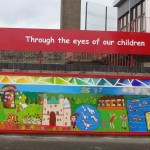
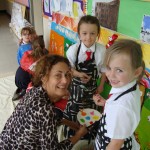

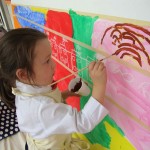

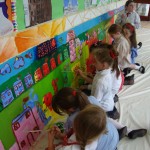
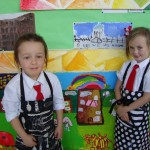
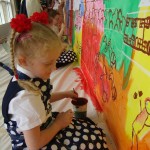
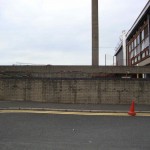
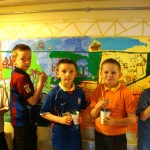
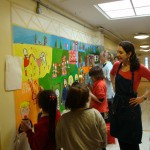
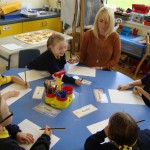
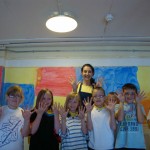
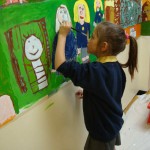
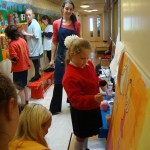
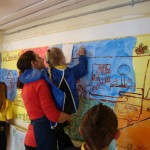
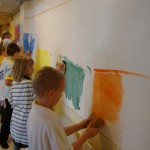
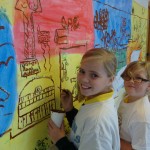
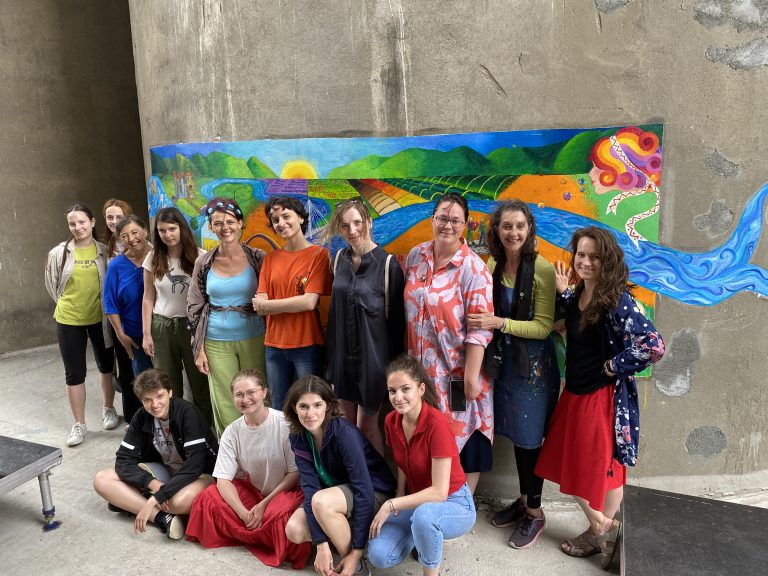

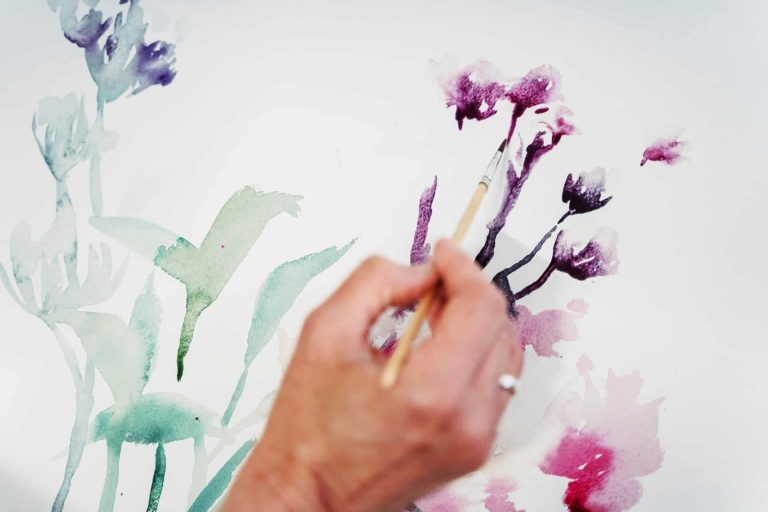

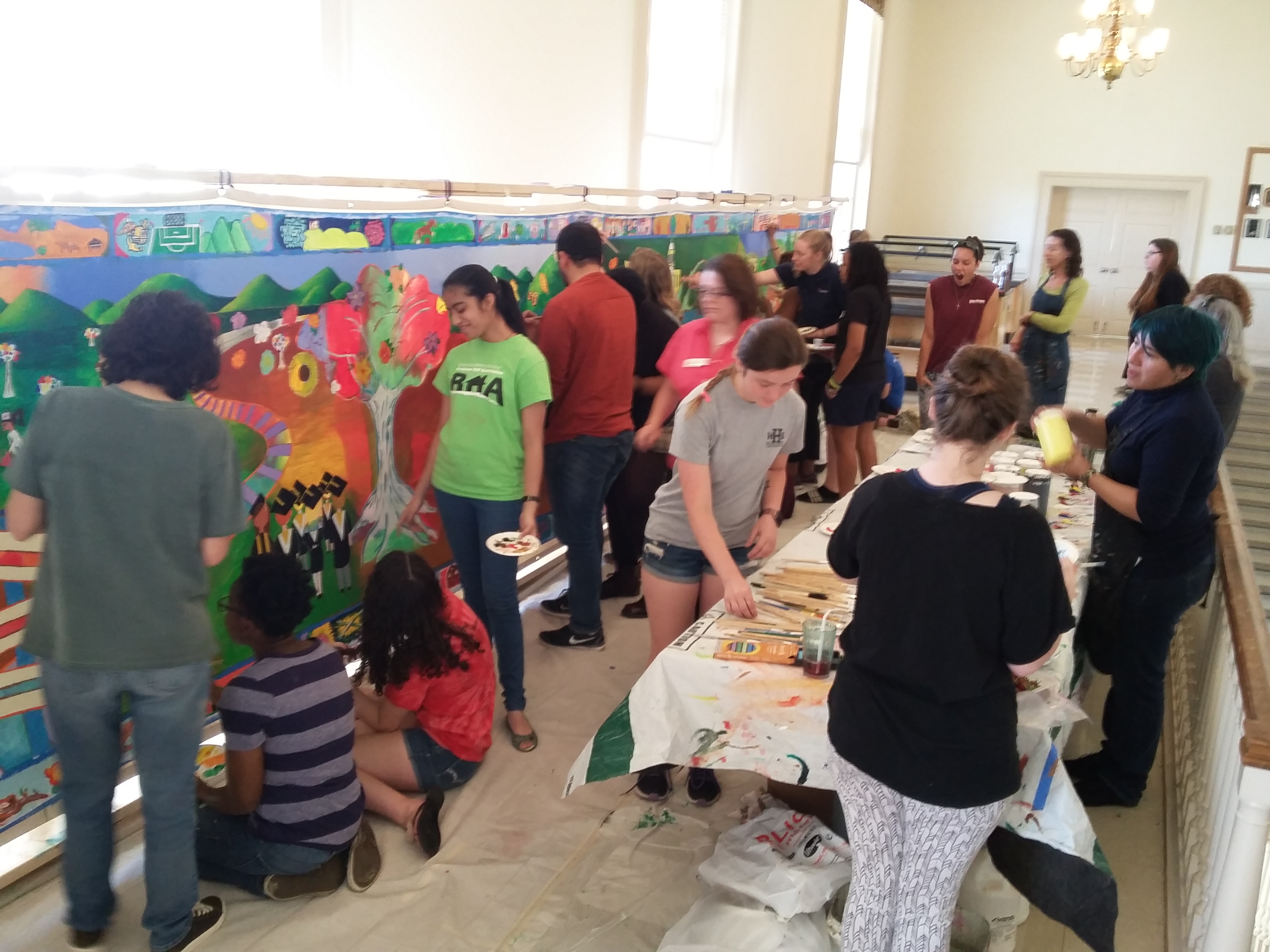

Awesome post.